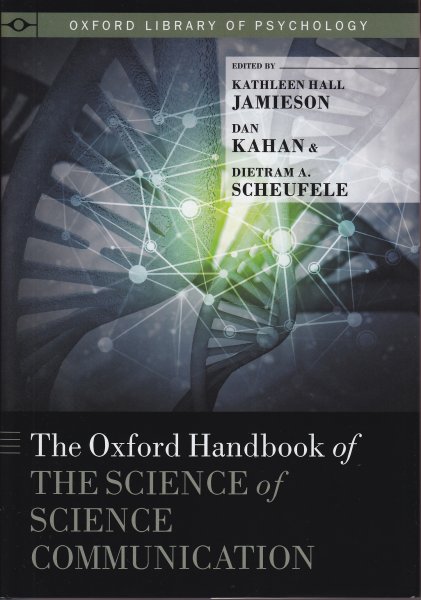
Publisher: Oxford University Press
Publication Year: 2017
Binding: Hardback
Page Count: 486
ISBN Number: 978-0-19-049762-0
Price: £ 105.00
The Oxford Handbook of The Science of Science Communication
There is growing acknowledgement within the scientific community that if we are to get science’s voice heard then we need to better understand our audiences and deliver more appropriate and effective communications. While science is grounded in empirical work and the evaluation of evidence, we have often failed to adopt a similar approach for science communication. This makes this new publication particularly timely, bringing together empirical evidence from fields as diverse as sociology, political science and biotechnology to examine how science can be best communicated.
Forty-seven chapters, authored by 57 different academics and professionals, are grouped into six broader areas to provide a comprehensive overview of this emerging subject. By distilling the knowledge and evidence being collected across a diversity of research, the editors have delivered a very useful tool for those working in science and science communication.
The editors of this volume set the contributions on a foundation of three core assumptions, the third assumption of which is perhaps the most important for researchers to engage with; this is that communication is an inevitable part of the process of characterising scientific findings, engaging other scientists with these findings and sharing them with policymakers and diverse publics. If we want people to understand and engage with our research – if we want our science to have impact – then it is inevitable that we have to communicate effectively and in a manner appropriate for the intended audience.
The six parts to the book begin with an overview of science communication, outlining the key features of science communication as an emerging area of scientific enquiry. The synthesis provided in Chapter 2 by Heather Atkin and Dietram Scheufele is particularly useful in this regard, revealing how beliefs about science may be confounded by cultural influences and undermined by the social and political environments within which the communication takes place. Atkin’s own research, which is centred on public opinion dynamics and political communication, reinforces her contribution to this excellent overview. Later chapters in this part of the book explore how science is perceived in society and how evolving media structures are shaping the coverage and messaging of scientific stories. Importantly, this also includes an exploration of scientific literacy, which highlights important gaps in our current understanding.
Part two tackles the difficult topic of bias and weakness in scientific communication, something that is occasionally exploited by those wishing to attack science or scientific evidence – think about climate-change denial, for example. A key component of this part are the chapters that look at the scientific process, specifically peer-review and publication bias; these should be of great interest to researchers in their own right. Part three provides a series of case studies, drawn from work on food safety, GMOs, human health and nanotechnologies. These real world examples are used to highlight some of the successful approaches for science communication and to reveal some of the potential pitfalls.
Part four examines some of the voices that are used to communicate science, from the traditional journals and scholarly presses through to funders, social networks and government organisations. This recognises the need for science to be taken out of the traditional academic arenas and translated and communicated to other audiences, a process that requires active participation and understanding on the part of academics and their communication teams. The use of scientific information by third parties, such as the media, the entertainment industry and comedy, forms the basis of part five. Since it is through these third parties that much of wider society encounters science, the authors of these chapters argue that academics and researchers need to be better informed and/or trained before they interact with these channels.
Part six recognises that science sometimes resides within an environment that is both hostile and highly polarised, and that this can damage perceptions of science and the scientific method more widely. Examples from work on childhood immunisation, GMOs and climate change are used to illustrate the challenges still faced in this environment. The book ends with a final chapter, which seeks to summarise the evidence presented elsewhere in the text and sets a future direction for the science of science communication. This chapter could, to my mind, have been a bit longer and drawn more strongly on some of the key points emerging from the material presented by other contributing authors.
The Oxford Handbooks series seeks to provide authoritative and up-to-date reviews of original research across a very broad suite of topic areas, from rhetorical studies to international law and the management of megaprojects. This particular book delivers on these aims and feels especially timely. Putting aside the cover price, this is a book that those working in science communication should read, as should those researchers keen to see their work communicated effectively to key audiences.Book reviewed by Mike Toms






Share this page